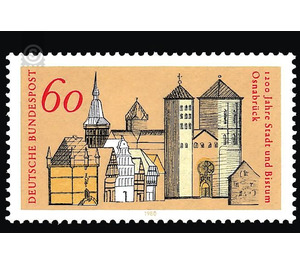1200 years of the city and diocese of Osnabrück - Germany / Federal Republic of Germany 1980 - 60 Pfennig
| Country | Germany / Federal Republic of Germany |
| Issue Date | 1980 |
| Face Value | 60.00 |
| Color | brown |
| Perforation | K 14:14 1/4 |
| Printing Type | combined intaglio and offset printing |
| Stamp Type | Postage stamp |
| Item Type | Stamp |
| Chronological Issue Number | 922 |
| Chronological Chapter | GER-BRD |
| Michel ID | BRD 1035 |
| SID | 152743 |
| In 38 Wishlists | |
Between Teutoburg Forest and Wiehengebirge, just before the transition from the Osnabrücker Berglandes in the North German Plain, lies the old bishop, citizen and Hanseatic city and young university town Osnabrück. When Charlemagne founded the foundation of the first bishopric in the Saxon country, the beginning of the city, can not be said with any certainty. An old Osnabrück rhyme chronicle tells that in 772 Charlemagne celebrated Easter in Osnabrück. For this reason, the Osnabrück celebrated their 1,000th anniversary in 1772. The Göttingen professor, scientist and philosopher G. Chr. Lichtenberg reported as eyewitness about it. Later, scientists found out that the date was wrong. Thus, at the beginning of the largest Westphalian town in Lower Saxony, legends and legends and Carolingian documents changed the later bishops. Of the first documents, nothing remained but the parchment and the signature of Charlemagne. Important historical sources, such as the Annales Regni Francorum, the Lorsch Annalen or the Osnabrückische Geschichte of the incomparable Justus Möser, statesman and founder of a critical historiography, which Goethe called the "splendid Patriarch of Osnabrück", make it seem assured. that the year 780 is not wrong as the founding date. As early as 785, the first cathedral was consecrated by Bishop Agilfred of Liège. The construction should have lasted for seven years. Accordingly, immediately after the decision of Charlemagne at the Diet in Paderborn in the year 777, to build bishoprics in Saxony, the construction of the Osnabrück cathedral must have begun. The present third dome, which was built in all centuries and survived wars and fires, is one of the major cathedrals of the West. As the first bishop church in the old Saxonia Westphalia he was consecrated to the apostolic prince pc. Peter. Around the Domburg developed with the Binnenburg the citizen city and later with the Butenburg the Hanseatic city with the three other main churches of the Middle Ages, the civic churches of St. Mary, St. Catherine and the collegiate church of St. John in the historic New Town. In the immediate vicinity of the cathedral area, which still today is the spiritual center of the largest German diocese in terms of area, the city center with the Marienkirche and the late Gothic town hall was built with the market. From 1643 to 1648 the Westphalian Peace of Osnabrück and Münster was negotiated here, which ended the Thirty Years' War and rearranged the state structure of Europe. For the first time in history, the "Instrumentum pacis Osnabrugense" established constitutional freedom of belief and conscience. (Text: City and Diocese of Osnabrück)
| Condition | Name | In Stock | Price | Price + Shipping | Store | |
|---|---|---|---|---|---|---|
 | Unmounted Mint ** | 1200 years of the city and diocese of Osnabrück - Germany / Federal Republic of Germany 1980 - 60 Pfennig | 10 | US $0.641 | US $3.84 |  FILATELIELOKET (0) FILATELIELOKET (0)Shipping US $3.20 Minimum Order US $2.67 |


